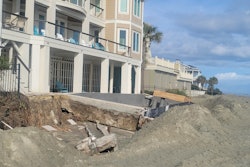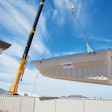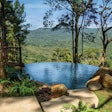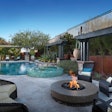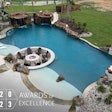
It was a hot evening on October 21, 2007 when a massive wildfire raged through the foothills of an area just north of Irvine, Calif. Known as the Santiago fire, the blaze was part of a region-wide onslaught of infernos that stretched from Santa Barbara to the Mexican border, consuming more than half a million acres, 1,500 homes, killing 16 firefighters and injuring 85. More than a million people were evacuated from their homes.
Welcome to fire season in Southern California. Every year from June to October, the infamous Santa Ana winds coupled with expanses of dried vegetation in the region’s hills and canyons routinely fuel fires of almost unimaginable ferocity. Although the spat of fires that broke out in late October 2007 stand among the worst in U.S. history, such conflagrations are far from unusual, nor are they by any means exclusive to California.
According to the National Interagency Coordination Center, wildfires consumed more than 8 million acres in a dozen states in 2012.
As a Southern California native, I grew up with the threat of wildfires and have become all too familiar with their devastating effects. I’ve been forced to evacuate twice, and know people who have lost their homes. The images of fires raging through the hills, canyons and semi-rural neighborhoods have been forever imprinted in some of my most terrifying memories.
Among the most recurring scenes are the evening news helicopter flyover views of devastated neighborhoods where it’s tragically common to see swimming pools full of water just steps away from the smoldering remains of someone’s home. Most of these homes are located in what are known to some as suburban interface zones, places where often-affluent homeowners live on the cusp of open land. As it turns out, many own pools.
The irony of an available body of water located just feet away from a home that burns to the ground is not lost on people who have been much too close to the flames. One of those is a college buddy of mine, Ed Gogin, who on that blistering October evening in 2007 came face to face with the Santiago fire as it threatened his home.
Fortunately, Ed thought ahead when he had a massive backyard pool and spa built on his property back in the early 90s. His property, like many, borders a natural landscape that by nature’s design was certain to burn at some point. I remember him telling me, “It’s not if this area will burn, it’s just a matter of when.”
With that in mind, Ed purchased a portable pump and fire hose assembly he or firefighters could use to access the 35,000 gallons of water contained in his pool. That equipment rested unused in a tool shed on the property for nearly 15 years, waiting for the time it was needed to help save Ed’s family’s beautiful home. Not only did he make sure his firefighting system was always in operable condition, he also located two fire mains on his sprawling property and had his custom-built home fitted with an emergency sprinkler system and a fire-retardant tile roof.
Suffice to say, he was more than ready that night when the Santiago fire approached his home.
These days, Ed rightfully loves to tell the story of how he and a fire crew worked side by side through the night, using water from the mains and the pool to douse the home and fight the flames that reached more than 30 feet high just outside his fence. As it turned out, his home was located at a strategic point and the fire crews set up shop on his property — some even slept beneath his gazebo. It’s a great story and one that teaches a valuable lesson: had he not been so prepared, it’s very likely his home would have become an unfortunate statistic.
I bring this up here in our July issue, smack in the heart of fire season, for one big reason: to remind those of us in the aquatics industries to recognize that residential bodies of water, be they pools and spas, ponds and streams, large fountains or rainwater capture reservoirs, can and should be viewed as ready resources for fighting fires. Many regions are currently experiencing drought conditions and in recent years have seen stretches of record high temperatures during the summer, factors that contribute to the likelihood of widespread catastrophe.
These days, there are a handful of firms that specialize in swimming pool fire-fighting equipment, but by and large, the concept of using pools to save homes remains relatively obscure. That needs to change.
All of this is why I’m urging you — whether you’re a builder, retailer, or service technician — if you have clients located in areas that are potentially susceptible to fire, do whatever you can to encourage those homeowners to equip themselves with systems that will enable their pools to become a firefighting resource. It’s a message that just might wind up being the most valuable you’ve ever given.
Keep in mind that fighting wildfires can be a radically chaotic process that, at times, pits our brave firefighters against insurmountable conditions, including a lack of available water resources. Also keep in mind fire trucks contain anywhere from 500 to 1,000 gallons of water, while pools might hold anywhere from 1,500 to 40,000 gallons or more. It’s no stretch at all to imagine that the water in a pool could spell the difference between a close brush with disaster and devastating loss.
It’s really just common sense and well worth the investment in dollars and forethought. Because, as my forward-thinking buddy Ed told me recently: “Just knowing you have that capability gives you real peace of mind.”
Comments or thoughts on this article? Please e-mail [email protected].
























